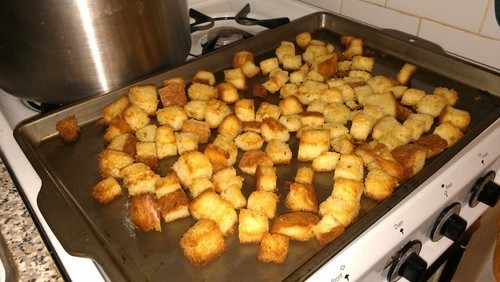Text
Medievalism: Le Livre des Manières
Lesbians are hardly ever mentioned in premodern texts. The few times they show up are in legal codes or court cases. Otherwise, you're hard pressed to find any explicit reference to female homosexual activity. Scholars of premodern lesbians (like myself) usually have to read between the lines. The only explicit reference to female homosexual activity is in Etienne de Fougères' Le Livre des manières. This text was written in a Breton dialect of Old French sometime between 1168 to 1178 by the Bishop of Rennes. It has survived in only one manuscript. Le Livre des manières is an estates poem, meaning that it provides instruction for proper behavior for all members of society. It is divided into six sections, but the part that interests us is the final section, which deals exclusively with women. After discussing the proper role of women in marriage, de Fougères takes up "lei pechié...encontre Nature:" the sin against Nature. The text mocks and dismisses these women, regarding their actions and unnatural and impossible. See below how he uses masculine or phallic language to describe the behavior of these women. He is unable to conceive of any relations between two women, because he and his medieval audience have no conception of sex without a penis.


Translation my own. For more information, contact me.
1 note
·
View note
Text
Medievalism: Penitentials!
Any Catholic will tell you that the confession of one's sins and any penance that follows are important parts of their religion. Reconciliation of the Penitent is a sacrament. I'm not Catholic, but I find the development of penance and the growing importance of confession to be an interesting subject in the study of the Middle Ages. Part of my research this semester is working with the Penitentials, a series of handbooks that were used by priests to take confession in the Early Middle Ages. Now, I could go into detail on why the Penitentials developed, what they signify, and how they spread across Europe, but that's not the part I want to share with you.
I think the Penitentials are really cool because they are devoted to discussing sins that people actually committed. The Penitentials provide us with an opportunity to see what people of the Early Middle Ages may have actually been doing. This ranges from foods eaten, skipping mass, adultery, and things children do together. Many of the Penitentials have sections devoted to sexual sins and acts. This is the area my research is focusing on, and along the way, I found, what I like to call, The Medieval Flowchart of Safe-sex. This flowchart is based on the Penitentials in determining what type of sex does or does not constitute a sin. It's pretty funny and a surprisingly accurate representation of the content of the Penitentials.

From James A. Brundage, Law, Sex, and Christian Society in Medieval Europe, p. 162.
0 notes
Text
Medievalism: Roman de Brut and Arthur
The BBC show Merlin is one of my absolute favorite things ever. No lies: I'm a fangirl. Check out my other blog for evidence of this fact. In addition to the show, I'm also a fangirl of the original lore. Arthurian and Merlinian legend are what put me on the path to medieval studies. The stories of Arthur and Merlin originate out of Wales and take place in the late 5th and early 6th centuries. The legend survives the arrival of the Anglo-Saxons and the Norman Conquest via Welsh versions of the story. Then, in 1136, Geoffrey of Monmouth brings Arthur and Merlin to the rest of Europe via the Historia regum Brittaniae. Wace, a Norman poet, did the most to bring Arthur and Merlin to the front of the European literary world with his Roman de Brut. It was the first extended account of Arthur's life in French, the post popular language of literature for the Middle Ages. It tells the history of the kings of Britain from the first king, Brutus, to the invasion of the English. The part I want to share with you (lines 13275 to 13298) from Judith Weiss' translation of the text) is after Arthur's death and the prophecy of his return. The text was originally written in Anglo-Norman, the dialect of French spoken in England through the 14th century. I present the French first and then the translation.
Arthur, si la geste ne ment,
Fud el cors nafrez mortelment;
En Avalon se fist porter
Pur ses plaies mediciner.
Encore i est, Bretun l'atendent,
Si cum il dient e entendent;
De la vendra, encor puet vivre.
Maistre Wace, ki fist cest livre,
Ne volt plus dire de sa fin
Qu'en dist li prophetes Merlin;
Merlin dish d'Arthur, si ot dreit,
Que sa mort dutuse serreit.
Li prophetes dist verité;
Tut tens en ad l'um puis duté,
E dutera, ço crei, tut dis,
Se il est morz u il est vis.
Porter se fist en Avalun,
Pur veir, puis l'Incarnatiun
Cinc cenz e quarante dous anz.
Damage fud qu'il n'ot enfanz.
Al fiz Cador, a Constentin,
De Cornuaille, sun cusin,
Livra sun regne si li dist
Qu'il fust reis tant qu'il revenist.
Arthur, if the chronicle is true, received a mortal wound to his body. He had himself carried to Avalon, for the treatment of his wounds. He is still there, awaited by the Britons, as they say and believe, and will return and may live again. Master Wace, who made this book, will say no more of his end than the prophet Merlin did. Merlin said of Arthur, rightly, that his death would be doubtful. The prophet spoke truly: ever since, people have always doubted it and always will, I think, doubt whether he is dead or alive. It is true that he had himself borne away to Avalon, five hundred and forty-two years after the Incarnation [of Christ]. It was a great loss that he had no children. To Cador's son, Constantine of Cornwall, his cousin, he surrendered his kingdom, and told him to be king until he returned.
3 notes
·
View notes
Text
How to make: Croutons!
I love fresh food: fruit, vegetables, cookies. Best of all, though, is fresh bread. I have a bread machine, and I absolutely love it. The problem I constantly face, though, is what to do with the leftovers. I live alone and can't (usually) eat a 2 lb. loaf of bread. I think most of us are in this situation. So what do you do? Well, the easiest answer is to throw it out, but I've never been a fan of wasting food. Leftover bread makes great French toast, but not all of us have time for that on a daily basis. What I've begun to do is find recipes that make use of old bread. One of these, croutons, is also a great encouragement for eating more salads. Below, you'll find my recipe and advice for making croutons.

1.Take a small bowl or shallow dish and mix up your olive oil, spices, and cheese. Mixing everything in now gives the olive oil time to soak up the flavors. Preheat your oven to 350.
2. Now you need to measure out your breadcrumbs. If you make your own bread, it's best to take bread that is 2 or so days old. It can be older than that, just no mold. I use white bread, but you could use french, ciabatta, or wheat. Rye and pumpernickel do not make for the best croutons. You can also used store-bought breadcrumbs or store-bought bread. Cut your bread into squares; aim for 1 cm by 1 cm.

2. Once you've cut up your bread, put them into a big bowl. One spoonful at a time, add your olive oil mixture and mix it in. Try to cover every breadcrumb.

3. Take out a large cookie sheet and spread out your breadcrumbs in a single layer. Bake 10 to 15 minutes or until they feel dry to the touch. They should be golden brown when down. Let them cool and then enjoy with a salad!

1 note
·
View note